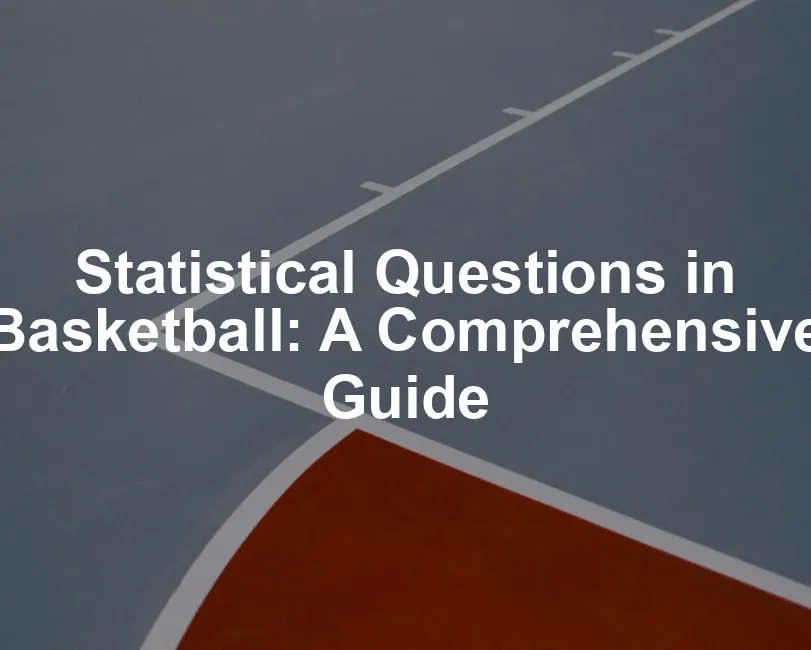Introduction
Basketball is more than just a game of shooting hoops. It’s a complex sport where every dribble, pass, and shot can be quantified. Statistics play a vital role in understanding player performance and overall team dynamics. They provide insights that can make or break a game.
But what exactly is a statistical question? In simple terms, it’s a question that anticipates variability in data. For instance, instead of asking, “How many points did LeBron James score last night?” we might ask, “What is the average points scored by LeBron James during the season?” The first question gives a singular answer, while the second opens up a world of data that can be analyzed for trends, patterns, and deeper insights.
Statistical questions are crucial in basketball analysis. They help coaches devise game strategies, assist players in improving their skills, and engage fans who are eager to understand the nuances of the game better. By exploring these questions, we gain a clearer understanding of performance metrics, team effectiveness, and even how a player’s statistics can influence their market value. So, grab your notepad and let’s jump into the fascinating world of statistical questions in basketball!

Understanding Statistical Questions
What is a Statistical Question?
A statistical question is one that anticipates variability and is answered by analyzing data. Unlike non-statistical questions, which yield a single answer, statistical questions allow for a range of responses. Think of it this way: if you ask, “How many points did Stephen Curry score last game?” you’re expecting one specific answer. However, if you ask, “What is the average number of points scored by Stephen Curry in a season?” you’re opening the door to a wealth of data.
In basketball, examples of statistical questions include:
- “What is the average number of assists per game for a player?”
- “How many rebounds does a team typically grab in a season?”
- “What percentage of games did a player score over 30 points?”
These questions rely on data collected over time, allowing analysts and fans to derive meaningful conclusions. By analyzing trends, we can identify patterns, such as which players excel in clutch situations or how a team’s performance changes after a key player is injured.
In contrast, a question like “What is Kevin Durant’s score in the last game?” is non-statistical. It gives a one-off answer without any room for analysis. Understanding this distinction is crucial for anyone looking to engage deeply with basketball statistics. The ability to formulate statistical questions opens up a treasure trove of insights into player performance and game strategies.

Importance of Statistical Questions in Basketball
Statistical questions are the backbone of informed decision-making in basketball. Coaches, players, and analysts rely on these questions to guide their strategies and improve performance. For instance, by examining questions like “What is the average shooting percentage for the team from the three-point line?”, coaches can develop targeted training sessions.
Statistical questions can also help in player evaluations. If a player consistently averages 20 points per game but has a low shooting percentage, it might indicate a need to refine their shot selection. Alternatively, a player with a high assist-to-turnover ratio could be viewed as a valuable asset for their ability to manage the game effectively.
Moreover, statistics create engagement among fans. As audiences become more knowledgeable about the game, they start to appreciate the intricacies behind each player’s performance. Questions like “What is the correlation between a player’s free throw percentage and their overall scoring ability?” can spark lively discussions and debates among fans and analysts alike.

By the way, if you’re serious about improving your basketball game, why not check out some Basketball Training Equipment? From dribble goggles to shooting aids, these tools can elevate your skills to the next level!
In essence, statistical questions not only enhance game strategies but also enrich the fan experience, making basketball more than just a sport—it transforms it into a captivating narrative woven with data-driven insights.
For a deeper dive into the significance of statistical questions in basketball, check out this article on statistical questions in basketball.
Types of Statistical Questions in Basketball
Basic Statistical Questions
Measures of Central Tendency
In basketball, understanding player performance often hinges on three key measures: mean, median, and mode. Let’s break these down in the context of player statistics.
First up is the mean, or average. It’s calculated by adding up all the points a player scored in a season and dividing by the number of games played. For instance, if a player scores 20, 25, and 30 points over three games, their mean score would be \( (20 + 25 + 30) / 3 = 25 \). This number gives coaches a general idea of how well a player is performing.
Next, we have the median. This measure is the middle value when all scores are arranged in order. If our player’s scores are 20, 25, and 30 again, the median is still 25. However, if they had another game where they scored 5 points, making their scores 5, 20, 25, and 30, the median would now be 22.5. This is particularly useful when evaluating performance because it reduces the impact of outlier performances, like a bad game where a player scored only two points.
Finally, there’s the mode, which represents the most frequently occurring score. If a player scored 20 points in five games but only 15 points once, then 20 is the mode. Knowing the mode can help teams identify a player’s typical scoring range, which is essential for game strategy.

These measures, when combined, provide a well-rounded view of a player’s scoring ability. Coaches and analysts can pinpoint trends, identify strengths, and even suggest areas for improvement, ensuring players are always moving toward their peak performance.
Variability in Data
When evaluating player performance, it’s not just about averages; variability in data is crucial too. This is where terms like range, variance, and standard deviation come into play.
Range is the simplest measure of variability. It’s calculated by subtracting the lowest score from the highest. If a player scores 5, 15, and 30 points in three games, their range is \( 30 – 5 = 25 \). A large range indicates inconsistent performance, while a small range suggests a player is more reliable in their scoring.
Variance takes this a step further. It measures how far each score deviates from the mean. The higher the variance, the more spread out the scores are. For example, if our player’s scores are wildly fluctuating between 5 and 30 points, their variance will be high. This information is vital; it tells coaches whether a player can be counted on for consistent scoring or if they’re more of a wild card.
Standard deviation is simply the square root of variance and provides a more digestible number. It shows how much a player’s scores typically differ from the average. A player with low standard deviation is consistently scoring close to their average, which is exactly what teams want in high-pressure situations.
Understanding variability helps coaches make informed decisions about player rotations and strategies. If a player has high variability, coaches might decide to adjust their role in certain games based on matchups or other factors. In short, variability adds depth to player analysis, revealing the underlying patterns that averages alone can’t show.
Advanced Statistical Questions
Correlation and Regression Analysis
Now, let’s step up the game and tackle advanced statistical questions, particularly correlation and regression analysis. These tools help us understand the relationships between different player statistics.
Correlation measures the strength and direction of a relationship between two variables. For example, we might look at the correlation between assists and points scored. If players who assist more often also score more points, we have a positive correlation. This insight can guide coaches in developing better offensive strategies. If a player consistently assists before scoring, teams may want to encourage that play style.
Then there’s regression analysis, which dives deeper into these relationships. It allows us to predict a player’s performance based on various factors. For instance, multiple linear regression can analyze how points scored depend on assists, rebounds, and minutes played. The formula looks something like this: \( Y = \beta_0 + \beta_1 \times X_1 + \beta_2 \times X_2 + \beta_3 \times X_3 \). Here, \( Y \) represents points scored, and \( X_1, X_2, X_3 \) could be assists, rebounds, and minutes played, respectively.
Using regression, analysts can identify which factors most significantly impact a player’s scoring. If assists have a high coefficient, it means they’re a key predictor of points. Coaches can then tailor training to improve those skills, helping players maximize their scoring potential.
Moreover, regression analysis is great for predicting outcomes in future games. By inputting current player stats, coaches can forecast potential performance against different teams. This kind of insight not only aids in strategy formulation but can also influence player trades and team composition over time.
In conclusion, mastering correlation and regression analysis allows teams to unlock deeper insights into performance, leading to smarter decisions on and off the court. This analytical approach elevates basketball from a game of chance into a well-oiled machine driven by data.

Probability and Expected Outcomes
When we think about basketball, our minds often drift to high-flying dunks and three-pointers. But beneath the surface, probability plays a crucial role in shaping the game we love. Imagine you’re at the free-throw line, sweat trickling down your brow. What’s your likelihood of sinking that shot? This is where free throw success rates come into play. Players have their own unique percentages, and over time, these numbers help coaches decide who should take those crucial shots.
Free throw shooting is a classic example of probability in action. Each attempt is treated as an independent event, much like flipping a coin. If a player has a free throw percentage of 80%, they’re expected to make 8 out of every 10 attempts—on average. Coaches can leverage this data to predict game outcomes, determining who to trust in clutch situations. It’s not magic; it’s math!
Now, let’s take a closer look at binomial probability. This statistical concept is significant in player analytics. Binomial probability helps us understand scenarios with two possible outcomes—success or failure. In our basketball context, success could mean making the shot. By applying the binomial probability formula, we can calculate the likelihood of a player hitting a specific number of successful free throws.
For instance, if a player takes 5 free throws, the probability of making exactly 3 can be calculated using the binomial formula. This is vital for coaches, as it provides insights into player performance under pressure. If a player frequently lands below their expected success rate, it raises flags. Perhaps they need more practice, or maybe the pressure is getting to them.
Understanding these probabilities can also help fans appreciate the game better. Instead of just cheering for every basket, they start to analyze the odds of making that shot. With each dribble, players are not just playing; they’re engaging in a mathematical dance that determines the fate of the game.
In summary, probability and expected outcomes are not just abstract concepts; they’re integral to basketball strategy and player performance. With every shot taken, there’s a world of data behind it, guiding decisions and shaping the excitement of the game. So, the next time you watch a game, remember: it’s not just about scoring points; it’s about understanding the probabilities that make those points possible.

Case Studies of Statistical Questions in Basketball
Player Performance Analysis
When it comes to evaluating player performance, statistics are the golden key. Coaches and analysts rely on various statistical models to assess a player’s skills and contributions effectively. Let’s break down some of the essential metrics used in player performance analysis.
Take shooting percentage, for example. This statistic measures how efficiently a player converts their shots into points. Coaches love it because it gives a clear picture of a player’s scoring ability. If a player has a high shooting percentage, they’re likely a reliable scorer. But wait, there’s more! This figure can be broken down further into field goal percentage and three-point percentage, offering deeper insights into a player’s shooting prowess.
Next up is the assist-to-turnover ratio, a vital metric for evaluating a player’s decision-making skills. A player with a high assist-to-turnover ratio demonstrates a knack for creating scoring opportunities while minimizing mistakes. This is crucial for point guards, who are often the playmakers of the team. By analyzing this ratio, coaches can identify players who excel in facilitating the game.
Moreover, advanced metrics like Player Efficiency Rating (PER) take performance analysis to a whole new level. PER consolidates a player’s contributions into a single number, accounting for various factors such as scoring, assists, rebounds, and even defensive plays. This holistic view allows coaches to compare players across different positions and playing styles.

But how do all these stats translate into real-time impact? Let’s consider a case study of a player who has an impressive field goal percentage but a low assist-to-turnover ratio. This player may excel at scoring but struggles to involve teammates. Coaches might use this information to adjust game strategies, encouraging the player to focus on facilitating more.
In essence, statistical models are like a magnifying glass for player performance. They allow coaches to dissect strengths and weaknesses, helping to tailor training regimens and strategies. With the right analytics, teams can unlock the full potential of their players, turning raw talent into winning performances.
Team Strategy and Game Analysis
In the world of basketball, statistics aren’t just numbers; they’re the backbone of team strategy and game analysis. Coaches are like chess players, using data to formulate strategies that can outsmart opponents. Let’s dive into how teams harness the power of statistics to gain a competitive edge.
One of the primary areas where statistics come into play is in evaluating defensive setups. By analyzing opponent shooting percentages from various areas of the court, coaches can adjust defensive strategies. For example, if data shows that a rival team excels at three-point shooting, a coach may decide to tighten perimeter defense. This data-driven decision-making helps teams adapt in real-time, creating opportunities to disrupt opposing offenses.
Shot selection is another critical aspect influenced by statistics. Coaches analyze shot locations and success rates to determine the best offensive strategies. For instance, a team might find that shots taken from the corner three-point line have a higher success rate than long-range shots. Armed with this knowledge, they can design plays that maximize scoring chances.
Moreover, advanced metrics like effective field goal percentage (eFG%) factor in the value of three-point shots compared to two-point shots. This allows coaches to evaluate offensive efficiency more accurately. If a player consistently takes low-percentage shots, coaches may intervene to refine their shot selection.
In-game analytics also play a role. Coaches can use real-time data to make quick decisions, like calling timeouts or adjusting lineups based on player performance trends. If a player is on fire, they might receive more touches. Conversely, if another player is struggling, they could be benched for a bit to regain composure.

Ultimately, statistics empower teams to be proactive rather than reactive. By relying on data, coaches can craft strategies that enhance performance, giving their team the best chance of success. The beauty of basketball lies not just in the athleticism but in the strategic dance fueled by numbers. So, the next time you watch a game, remember the intricate web of statistics that guides each play and decision on the court.
Historical Data and Trends
Basketball statistics have transformed significantly over the decades. Analyzing historical data reveals exciting trends that shape how teams play today. One of the most noticeable changes is the rise of three-point shooting. In the 1980s, three-point shots were a rarity. Players focused on two-point field goals, and the three-point line was merely a suggestion. Fast forward to today, and it’s a different ball game entirely.
The NBA has seen three-point attempts skyrocket. In the 1980-81 season, teams averaged just 0.7 three-point attempts per game. Now, that number hovers around 35 attempts per game! Coaches and players have embraced the three-point shot as a vital scoring method. This shift has redefined offensive strategies, leading to a more perimeter-oriented game.
But why the sudden love for shooting from deep? It all comes down to data. Analyzing shooting efficiency revealed that three-point shots yield more points if a player can convert them at a decent rate. For instance, shooting 33% from beyond the arc is statistically equivalent to shooting 50% from two-point range. This realization has coaches rethinking their game plans, prioritizing spacing and ball movement to create open looks from deep.
Also, advanced analytics have spotlighted players who excel in three-point shooting. With the use of player tracking technologies, teams can assess shooting mechanics, shot selection, and defensive matchups. The data allows for targeted training, helping players refine their long-range shooting skills. It’s no surprise that we now see specialists dedicated solely to three-point shooting.
Historical data also highlights the evolution of the game’s pace. Faster play leads to more possessions and, consequently, more scoring opportunities. Teams that can adapt to this trend often find themselves at the forefront of competition.

As basketball continues to evolve, historical trends guide teams in making strategic decisions. From the rise of three-point shooting to the emphasis on pace and space, understanding these trends is crucial for success. The future of basketball will undoubtedly be shaped by the data-driven insights gleaned from the past.
Tools and Resources for Basketball Statistics
Statistical Software and Tools
In the world of basketball analytics, having the right tools is essential. Coaches and analysts often turn to software like R and Python to crunch the numbers. These platforms offer powerful statistical capabilities, making it easier to analyze player performance and team dynamics.
R is particularly popular due to its extensive libraries tailored for statistical analysis. Analysts can create complex models to predict outcomes, assess player efficiency, and visualize data in engaging ways. R’s user-friendly syntax allows for efficient data manipulation, making it a go-to for data scientists in the sports realm.
Python, on the other hand, is widely known for its versatility. With libraries like Pandas for data manipulation and Matplotlib for visualization, it allows analysts to efficiently handle large datasets. Whether it’s player stats or game outcomes, Python can process this information and provide insights that matter.
Both R and Python have vibrant communities, offering support and resources for users. Online forums, tutorials, and open-source projects help users refine their skills and make the most of these software tools. Whether a coach is looking to analyze shooting patterns or a player wants to assess their performance, these platforms provide the flexibility needed to succeed.

Other software, such as Tableau and Microsoft Excel, also play critical roles in basketball analytics. They allow users to visualize data effectively, making it easier to communicate insights to players and coaching staff. With these tools, teams can stay ahead of the competition and make informed decisions based on solid data.
In conclusion, the right statistical software is vital for basketball analytics. R and Python lead the pack, but other tools also contribute to the growing field of basketball statistics. With these resources at their disposal, teams can analyze performance, develop strategies, and ultimately achieve greater success on the court.
Data Sources
Finding reliable data sources is crucial for basketball analysis. There are several platforms that provide comprehensive statistics, making it easier for analysts to gather insights. One of the most prominent sources is the official NBA website. It offers a treasure trove of player stats, team performance data, and game summaries. This data is essential for understanding player efficiency and evaluating team dynamics.
Additionally, sports databases like Basketball-Reference and StatMuse are invaluable resources. They provide historical data, advanced metrics, and even player comparisons. This wealth of information allows analysts to draw connections between player performance and team success over the years.
Another excellent source is the public datasets available through Kaggle. This platform features numerous basketball-related datasets, ranging from player statistics to game outcomes. Analysts can leverage these datasets for various projects, including machine learning models and predictive analytics.
Moreover, social media platforms like Reddit often host discussions around basketball statistics. Communities like r/nba provide insights into statistical questions that fans and analysts want to explore. Users can share findings and ask for help, creating a collaborative environment.
It’s essential to ensure that data sources are reliable and up-to-date. Using outdated information can lead to inaccurate conclusions and misguided strategies. Analysts must vet their sources, ensuring the data reflects current trends and player performance.

In summary, effective basketball analysis hinges on utilizing reliable data sources. Websites like NBA.com and Basketball-Reference, along with platforms like Kaggle and Reddit, provide a robust foundation for analytics. By tapping into these resources, coaches and analysts can make informed decisions that enhance team performance and player development.
Conclusion
Statistical questions are the unsung heroes shaping basketball’s future. They impact how players train, how coaches strategize, and how fans appreciate the game. By analyzing stats, teams can identify strengths and weaknesses, leading to smarter game plans. Imagine a coach fine-tuning a player’s shooting technique based on their shooting percentage. That’s the power of statistics at work!
In today’s basketball landscape, data literacy is vital. Players need to understand their stats to improve. Coaches must interpret data to make informed decisions. Even fans benefit when they grasp the numbers behind the game. A knowledgeable fan can engage in deeper discussions about player performance and team strategy. It transforms mere spectators into informed enthusiasts.
As basketball continues to evolve, statistical analysis will play an increasingly prominent role. With advancements in technology and data collection, the insights gained from stats will only grow. Teams that can leverage this information effectively will gain a competitive edge. The future of basketball is deeply intertwined with the ability to ask the right statistical questions and act on the answers.
So, whether you’re a player aiming for the next level, a coach refining your strategy, or a fan wanting to be more than a casual observer, embracing statistics is the way forward. In the end, the right questions lead to the best answers, and in basketball, those answers might just lead to victory!
And speaking of victory, don’t forget to equip yourself with some stylish NBA Team Jerseys to show your support while analyzing those stats!
FAQs
What are some common statistical questions in basketball?
Basketball analysis thrives on a variety of statistical questions. Here are a few that often come up: – **What is a player’s shooting percentage?** This tells us how many shots a player makes out of their total attempts. It’s crucial for evaluating scoring efficiency. – **How many rebounds does a player average per game?** This statistic helps gauge a player’s impact on both ends of the court. Rebounding can dictate possessions! – **What is the average points per game for a team?** This figure indicates overall offensive performance and can be vital for comparing teams. – **What is the assist-to-turnover ratio?** This measures how effectively a player distributes the ball while minimizing mistakes, crucial for point guards. – **How many three-pointers does a player make compared to attempts?** This highlights a player’s long-range shooting ability, an increasingly important skill in modern basketball. These questions help analysts, coaches, and fans get a clearer picture of player performance and team strategy, enriching discussions around the game.
How can I use statistics to improve my basketball skills?
Applying statistics to improve basketball skills is a game-changer. Here’s how players can utilize data: – **Track your shooting percentages.** By recording how many shots you make from different areas on the court, you can identify strengths and weaknesses. If you consistently shoot poorly from the three-point line, it’s time to put in extra practice. – **Analyze your free throw success rate.** Understanding your free throw percentage can help you focus on your technique during practice. Who wants to miss those critical game points? – **Evaluate your assist-to-turnover ratio.** This helps in understanding your playmaking abilities. If your turnovers are high, consider working on decision-making under pressure. – **Study game footage.** Watching recordings of your games, combined with stats, can reveal patterns in your performance. Maybe you excel against certain defenses but struggle against others. – **Set measurable goals.** Use statistics as benchmarks to track your improvement over time. Aim for a specific increase in your points per game or a decrease in turnovers. By incorporating statistics into your training regimen, you’ll gain valuable insights that can lead to significant improvements in your game.
Why is understanding statistical questions important for basketball fans?
Understanding statistical questions enhances the basketball viewing experience for fans. Here’s why this knowledge is beneficial: – **Deepens engagement.** When fans grasp the stats behind the game, they can better appreciate player performances and coaching decisions. It’s like being in the know, making every game more exciting! – **Encourages informed discussions.** Knowledgeable fans can engage in meaningful conversations about players, teams, and strategies. Whether at the water cooler or on social media, these discussions enrich the community. – **Enhances the overall experience.** Stats can explain why a team won or lost. Recognizing trends, such as a player’s clutch performance, adds context to the game, making each play more thrilling. – **Fosters a connection with the game.** Fans who understand statistics often develop a deeper emotional investment in teams and players. They aren’t just watching; they’re analyzing and celebrating every achievement. – **Promotes critical thinking.** Understanding stats encourages fans to think critically about the game. Questions like “Why did the coach make that substitution?” or “What’s the significance of that shooting percentage?” become natural. In short, statistical literacy transforms basketball from a simple spectator sport into a rich tapestry of strategy and drama, making every game a thrilling experience.
Please let us know what you think about our content by leaving a comment down below!
Thank you for reading till here 🙂
And don’t forget to stay hydrated during those intense games with a Sports Water Bottle that keeps your drink cool!
All images from Pexels




